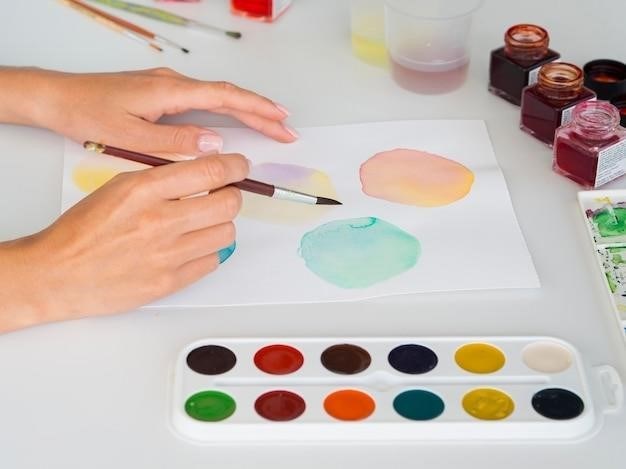Free Watercolor Tutorials for Beginners
The world of watercolor painting is vast and exciting, offering endless possibilities for creativity and expression. Whether you’re a complete beginner or looking to enhance your skills, there are countless free watercolor tutorials available online to guide you on your artistic journey. These tutorials cover a wide range of subjects, from basic techniques to advanced concepts, making it easy to find the perfect resource for your needs.
Introduction
Watercolor painting, with its vibrant hues and ethereal washes, has captivated artists for centuries. Its unique characteristics, from its translucent nature to its ability to blend seamlessly, create a captivating visual experience. However, embarking on a watercolor journey can feel daunting for beginners. The thought of mastering delicate brushstrokes and unpredictable water flow can be intimidating. But fear not! In today’s digital age, a wealth of free resources exists to guide you every step of the way. This article delves into the world of free watercolor tutorials, unveiling a treasure trove of knowledge that can transform you from a hesitant novice into a confident watercolorist. From basic techniques to advanced concepts, these readily accessible resources offer a gateway to unleashing your artistic potential and exploring the captivating world of watercolor painting.
What is Watercolor Painting?
Watercolor painting is a captivating art form that involves using water-soluble pigments, or paints, to create translucent washes of color on paper. The essence of watercolor lies in its inherent fluidity and unpredictability, allowing for both delicate washes and bold strokes. Unlike opaque paints, watercolor pigments are transparent, meaning that each layer of paint reveals the layers beneath, creating a captivating depth of color. This characteristic allows for a unique interplay of light and shadow, adding a luminous quality to watercolor paintings. Watercolor artists utilize a variety of techniques, from layering washes to creating dry brush effects, to achieve a wide range of textures and visual effects. The medium’s versatility makes it suitable for capturing a diverse array of subjects, from landscapes and portraits to abstract compositions, offering endless possibilities for artistic expression.
Benefits of Watercolor Painting
Watercolor painting offers a multitude of benefits for both beginners and experienced artists. It’s a highly accessible medium, requiring minimal supplies and setup, making it ideal for exploring creativity without significant financial investment. The fluidity and transparency of watercolor encourage a sense of freedom and spontaneity, allowing artists to embrace the unexpected and explore a wide range of styles. Watercolor also fosters a sense of mindfulness and focus, requiring careful control of water and pigment to achieve desired effects. The act of painting can be a meditative experience, promoting relaxation and stress reduction. Watercolor’s versatility makes it suitable for capturing the nuances of light and shadow, enhancing the beauty of natural subjects and offering a unique perspective on the world around us. Moreover, the potential for experimentation and exploration in watercolor painting fosters a sense of joy and accomplishment, making it an enriching and rewarding artistic pursuit.
Essential Watercolor Supplies

Before diving into the world of watercolor painting, it’s essential to gather a few basic supplies. A watercolor set with a range of colors is a great starting point. Look for a set that includes both warm and cool colors, as well as a selection of earth tones. A good quality watercolor paper is crucial for achieving vibrant and lasting results. Choose a paper with a rough or cold-pressed texture, as it provides better absorption and prevents the paint from bleeding excessively. A variety of brushes is also important, including round brushes for fine details, flat brushes for washes, and fan brushes for creating textures. A water container for rinsing brushes and a palette for mixing colors are essential. For convenience, a masking fluid can be used to protect certain areas from paint. A pencil for sketching outlines and a kneaded eraser for removing unwanted marks are also helpful additions to your watercolor kit. With these essential supplies, you’ll be well-equipped to embark on your watercolor painting journey.
Basic Watercolor Techniques
Mastering basic watercolor techniques is crucial for creating beautiful and expressive artwork. One fundamental technique is layering, where thin washes of color are applied one over the other to build depth and dimension. Wet-on-wet, a technique where wet paint is applied to wet paper, allows for soft blending and creates a dreamy effect. Conversely, wet-on-dry involves applying wet paint to dry paper, resulting in sharper edges and more defined shapes. To achieve subtle transitions and smooth gradients, use the “wash” technique, where a thin layer of paint is applied evenly across the paper. For creating textures and adding visual interest, experiment with “splattering” paint by flicking a loaded brush or using a toothbrush. “Lifting” paint with a damp brush or a sponge can be used to lighten areas or create highlights. Finally, “masking” with masking fluid or tape can help protect certain areas from paint, creating interesting effects and clean lines. These basic techniques provide a solid foundation for exploring the expressive world of watercolor painting.

Wet-on-Wet Technique
The wet-on-wet technique is a fundamental watercolor technique that involves applying wet paint to wet paper. This technique is known for its ability to create soft, blended transitions and dreamy, ethereal effects. The key to mastering this technique lies in understanding how water interacts with the paint and paper. When wet paint is applied to a wet surface, the water in the paint spreads and blends with the existing water, creating a seamless transition between colors. This allows for a spontaneous and unpredictable approach to painting, as the colors naturally flow and merge, creating unique and organic patterns. The wet-on-wet technique is often used to create backgrounds, skies, clouds, or any area where soft transitions and a sense of fluidity are desired. It’s also an effective technique for capturing the essence of light and shadow in landscapes and still life paintings. To achieve this effect, start by applying a wash of water to your paper, then add your desired colors while the paper is still wet. Experiment with different amounts of water and paint to see how they interact, and don’t be afraid to let the colors bleed and blend naturally. The wet-on-wet technique is a beautiful way to let your creativity flow, creating unique and captivating watercolor paintings.
Wet-on-Dry Technique
The wet-on-dry technique is a fundamental watercolor technique that involves applying wet paint to dry paper. This technique is known for its ability to create crisp edges, defined shapes, and precise details. The wet-on-dry technique is a great way to control the flow of the paint and create clean, sharp lines. It’s also a good technique for layering colors, as the paint will not bleed or blend as much when applied to a dry surface. To achieve this effect, allow your paper to dry completely before applying paint. Use a brush loaded with a concentrated amount of paint to create lines, shapes, or details. The paint will not spread as much as it would on a wet surface, allowing you to maintain control over its movement. This technique is often used to create details in landscapes, portraits, or still life paintings, where sharp edges and defined shapes are important. It’s also a great technique for creating textures and patterns, as the paint will not blend as much when applied to a dry surface. Experiment with different brush sizes and paint consistencies to see how they affect the outcome of your paintings. By mastering the wet-on-dry technique, you’ll be able to create watercolor paintings with a greater sense of detail and precision.
Layering Techniques
Layering is a key technique in watercolor painting that allows you to build depth, dimension, and complexity in your artwork. It involves applying multiple layers of paint, one on top of the other, to create a rich and nuanced effect. Each layer interacts with the previous one, creating subtle variations in color, texture, and opacity. The beauty of layering lies in its ability to create both subtle and dramatic effects. By layering lighter colors over darker ones, you can achieve a sense of luminosity and transparency. Conversely, layering darker colors over lighter ones creates a sense of depth and richness. Layering can also be used to create textures and patterns, as the paint will blend and interact differently on each layer. It’s important to allow each layer to dry completely before applying the next one to prevent blending and muddiness. Experiment with different colors, brushstrokes, and water-to-paint ratios to create unique and interesting layering effects. Mastering layering techniques will significantly enhance your ability to create expressive and captivating watercolor paintings.
Color Mixing and Blending
Color mixing and blending are fundamental aspects of watercolor painting, allowing you to create a wide range of hues and shades, adding depth and dimension to your artwork. Watercolor paints are transparent, meaning that the color of the paper beneath will influence the final color. This makes mixing and blending essential for achieving desired effects. Start by understanding the basic color wheel and how primary, secondary, and tertiary colors are created. Explore different mixing techniques, such as using a wet-on-wet approach for soft transitions or a wet-on-dry approach for sharper edges. Experiment with different ratios of water and paint to achieve varying levels of intensity and transparency. Blending involves seamlessly merging two or more colors together to create smooth gradients and transitions. Use light, gentle strokes to blend colors, allowing them to naturally flow into each other. Practice mixing and blending colors on a separate piece of paper before applying them to your artwork. By mastering color mixing and blending techniques, you’ll gain greater control over your watercolor palette and unlock a world of creative possibilities.
Creating Textures and Effects
Watercolor painting is not limited to smooth, flat washes. With a little experimentation, you can create a wide range of textures and effects that add depth, interest, and realism to your artwork. One simple technique is to use a dry brush, which involves using a brush that is only slightly damp with paint. This creates a textured, broken effect, ideal for depicting rough surfaces or adding movement to your painting. You can also use a variety of tools to create unique textures, such as sponges, crumpled paper, or even salt. Salt creates interesting patterns as the water evaporates, leaving behind a textured surface. Another technique is to use masking fluid, which creates a resist effect, allowing you to protect certain areas of your painting while you apply washes. For example, you can use masking fluid to create delicate flower petals or leaves. Experiment with layering different washes, using a variety of brushstrokes and techniques. By exploring different textures and effects, you can elevate your watercolor paintings from simple washes to captivating works of art;
Free Online Watercolor Resources
The internet is a treasure trove of free watercolor resources, offering a wealth of knowledge and inspiration for artists of all levels. YouTube is a great starting point, with countless channels dedicated to watercolor painting. You can find step-by-step tutorials, demonstrations of different techniques, and inspiration from artists around the world. Many artists also offer free downloadable resources, such as printable worksheets, reference photos, and color palettes. These resources can help you learn new techniques, practice your skills, and develop your own artistic style. Online watercolor communities and forums are also excellent resources for connecting with other artists, sharing tips, asking questions, and getting feedback on your work. Websites like Skillshare and Udemy offer free watercolor courses and workshops, providing structured learning opportunities with experienced instructors. Whether you’re looking for a quick tutorial or a comprehensive course, there are countless free online watercolor resources available to help you unlock your artistic potential and explore the world of watercolor painting.
Embarking on a watercolor painting journey can be both exciting and rewarding. With the abundance of free online resources available, there’s no need to feel intimidated or overwhelmed. From basic techniques to advanced concepts, these tutorials offer a personalized learning experience tailored to your individual needs and interests. Whether you’re drawn to landscapes, portraits, or abstract art, the world of watercolor is waiting to be explored. Don’t be afraid to experiment, embrace your unique style, and enjoy the process of creating beautiful and expressive artwork. Remember, the journey of learning watercolor is as much about the process as it is about the final product. So, grab your brushes, paints, and paper, and dive into the world of free watercolor tutorials. Let your creativity flow, and discover the joy of expressing yourself through this versatile and captivating art form.



